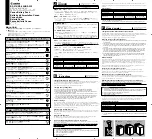
Operating Instructions
3
01283C
USE IN VICINITY OF BATTERY. REVIEW
CAUTIONARY
MARKINGS
ON
THESE
PRODUCTS AND ON ENGINE.
1.
Someone should be within range of your voice
or close enough to come to your aid when you
work near a lead-acid battery.
2.
Wear complete eye protection and clothing
protection. Avoid touching eyes while working
near battery.
3.
Have plenty of fresh water and soap nearby in
case battery acid contacts skin, clothing, or
eyes.
4.
If battery acid contacts skin or clothing, wash
immediately with soap and water. If acid enters
eye, immediately flood eye with running cold
water for at least 10 minutes and get medical
attention immediately.
5.
NEVER smoke or allow a spark or flame in
vicinity of battery or engine.
6.
Be extra cautious to reduce risk of dropping a
metal tool onto battery. It might spark or short-
circuit battery or other electrical part that may
cause explosion.
7.
Remove personal metal items such as rings,
bracelets, necklaces, and watches when
working with a lead-acid battery. A lead-acid
battery can produce a short-circuit current high
enough to weld a ring or the like to metal
causing a severe burn.
8.
Use charger for charging a LEAD-ACID battery
only. It is not intended to supply power to a low
voltage electrical system other than an
automotive application. Do not use battery
charger for charging dry-cell batteries that are
commonly used with home appliances. These
batteries may burst and cause injury to persons
and damage to property.
9.
NEVER charge a frozen battery.
CAUTION:
DO
NOT
OPERATE
THE
CHARGER IF IT IS DAMAGED OR APPEARS TO
BE MALFUNCTIONING. PERSONAL INJURY OR
DAMAGE
TO
THE
CHARGER
AND/OR
BATTERIES MAY RESULT.
PREPARING TO CHARGE
1.
If necessary to remove battery from vehicle to
charge, always remove grounded terminal from
battery first. Make sure all accessories in the
vehicle are off, so as not to cause an arc.
2.
Be sure area around battery is well ventilated
while battery is being charged.
Gas can be
forcefully blown away by using a piece of
cardboard or other non-metallic material as a
fan.
3.
Clean battery terminals. Be careful to keep
corrosion from coming in contact with eyes.
4.
Add distilled water in each cell until battery
reaches level specified by battery manufacturer.
This helps purge excessive gas from cells. Do
not overfill. For a battery without cell caps,
carefully
follow
manufacturer's
recharging
instructions.
5.
Study
all
battery
manufacturer's
specific
precautions such as removing or not removing
cell caps while charging and recommended
rates of charge.
6.
Determine voltage of battery by referring to car
owner's manual and make sure charger output
voltage is the same as battery voltage.
CHARGER LOCATION
1.
Locate charger as far away from battery as DC
cables permit.
2.
Never place charger directly above battery being
charged; gases from battery will corrode and
damage charger.
3.
Never allow battery acid to drip on charger when
reading gravity or filling battery.
4.
Do not operate charger in a closed-in area or
restrict ventilation in any way.
5.
Do not set a battery on top of charger.
DC CONNECTION PRECAUTIONS
1.
Connect and disconnect DC output clips only
after setting all charger switches to "OFF"
position and removing AC cord from electric
outlet. Never allow clips to touch each other.
2.
Attach clips to battery posts and twist or rock
back and forth several times to make a good
connection. This tends to keep clips from
slipping off terminals and helps reduce risk of
sparking.
NORMAL OPERATING INSTRUCTIONS
1.
With AC supply cord disconnected from outlet
and power switch in "OFF" position, connect DC
output clips to battery as described in (a) or (b)
below:
a.
FOLLOW THESE STEPS FOR A BATTERY
INSTALLED IN A VEHICLE. POSITION AC
AND DC CORDS TO REDUCE RISK OF
DAMAGE BY HOOD, DOOR, OR MOVING
ENGINE PART. STAY CLEAR OF FAN
BLADES, BELTS, PULLEYS, AND OTHER
PARTS THAT CAN CAUSE INJURY TO
PERSONS.
























